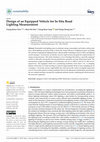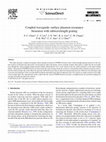Papers by Ching-cherng Sun
Optical Engineering, Aug 24, 2021

Sustainability
Sustainable road lighting aims to minimize energy consumption and reduce carbon emissions. Road l... more Sustainable road lighting aims to minimize energy consumption and reduce carbon emissions. Road lighting assessment helps evaluate the energy efficiency of lighting systems, including the selection of appropriate lighting fixtures, efficient lamp technologies (such as LED), and lighting control strategies. Assessments can identify areas for improvement and guide the implementation of energy-saving measures. This study introduces a new technology that utilizes a specially equipped vehicle to efficiently and quickly measure photometric quantities on long, illuminated roads. The measurement ranges for illuminance and luminance are (0.1 to 1000) lx and (0.1 to 100) cd/m2, respectively. The equipped vehicle has a positioning resolution of less than 1 cm. A sampling distance of less than 2 m while traveling at a speed of approximately 20 km/h and a sampling rate of 3 samples/s. To test the system’s applicability, the road used in this study was slightly sloped and curved. The results indi...

Optical engineering continues to impact more and more modern devices for communication, color dis... more Optical engineering continues to impact more and more modern devices for communication, color display, data storage, illumination, and remote sensing in the new millenium. The amalgamation of modern optics and associated microelectronic technologies has paved the road to greatly enhance new optoelectronic devices with practical applications. Modern optical technologies based on volume holography, both static and dynamic, have been developed over the past decade. Applications including high-density data storage, interconnections, spatial and temporal filters, beam shapers and combiners, gyros, and three-dimensional displays have been proposed and demonstrated. Simultaneously, more sensitive, efficient, and durable holographic materials have been developed. Novel optical elements based on volume holography perform unique functions, which have attracted much attention in modern science and engineering. Owing to the fast growth of the development of volume holographic optical elements, ...

Bullet-shaped LEDs are commonly used in self-luminous traffic signs as LED-dotted matrices due to... more Bullet-shaped LEDs are commonly used in self-luminous traffic signs as LED-dotted matrices due to their low cost, simplicity, robustness, and ease of installation. We proposed a simple low-cost method that creates a model suitable for the high manufacturing tolerance found in bullet-shaped LEDs. The method starts from measuring multiple one-dimensional angular intensity patterns at interested distances from multiple LEDs to form a database, including distances at 10, 15, 20, 25, 35, 50, and 100 mm. Their normalized cross-correlations are then calculated to find the batch that has the most similarity and base our model off that batch. Finally, we validate the model via Monte Carlo simulations in comparison to the original one-dimensional angular intensity patterns in the database. The platform demonstrated to obtain an average of 99% in normalized cross correlation between different batches of the same model LED, and a model of that LED is currently under development.
Optical Engineering, 2021
Abstract. A design scheme for an aspherical lens including two step processes is proposed and dem... more Abstract. A design scheme for an aspherical lens including two step processes is proposed and demonstrated to direct appropriate flux to the expected target illumination. The first-step design is based on a point source and the surface geometry is determined. The flux deviation between the design and target illumination becomes the factor in the optimization process, and the angular flux compensation is done to adjust the light pattern. Finally, the experimental result shows that high similarity between the target and the measurement is observed and full width at half maximum angle error is within 3%, which are both better than those in the aspherical lens design based a point source and a real light-emitting diode without optimization by flux compensation.
Algorithms and Systems for Optical Information Processing IV, 2000
ABSTRACT
Photorefractive Fiber and Crystal Devices: Materials, Optical Properties, and Applications III, 1997
Chinese Journal of Physics- Taipei-
We measured the signal beam intensity of two-wave mixing in a BaTiO3 crystal which was subjected ... more We measured the signal beam intensity of two-wave mixing in a BaTiO3 crystal which was subjected to a small vibration along the C-axis. The grating vector formed by the interference of the two beams was also along the same axis. The signal intensity as a function of vibration amplitude follows the prediction of a theory using a convolution of the vibration pulse and the grating itself. This approach may provide a probe to unveil various light-grating interaction mechanisms within photorefractive crystals.
Key Engineering Materials, 2007
A novel design of triple-wavelength design for a compact optical pickup head is presented here. W... more A novel design of triple-wavelength design for a compact optical pickup head is presented here. We propose the use of two rhomboid beam-splitter prisms for HD-DVD, DVD and CD devices to align signals with three different wavelengths on the same optical axis. The light is collimated by a collimating lens. The parallel beams are incident on the wavelength selector. The wavelength selector separates the wavelengths with different numerical apertures. The different wavelength signals are focused on the disc by an objective lens.
Algorithms, Devices, and Systems for Optical Information Processing III, 1999
ABSTRACT
Holography, Diffractive Optics, and Applications IV, 2010
ABSTRACT We summarize our theoretical study of the collinear volume holographic storage system. S... more ABSTRACT We summarize our theoretical study of the collinear volume holographic storage system. Simple formulas with direct physical concepts are developed under paraxial condition with scalar diffraction theory and VOHIL model, which are much helpful in figuring out the characteristics on point spread function (PSF) and the shift selectivity. Accordingly, effective system design is possible.
SPIE Proceedings, 1991
A hybrid pattern recognition system which consists of photorefractive crystal, SLM, and computers... more A hybrid pattern recognition system which consists of photorefractive crystal, SLM, and computers is designed and analyzed. In this system, photorefractive crystals are used as dynamic real-time recording materials and optical coherent spatial filters. The problems of excessive sensitivity to scale and rotation in general optical matched filters are solved by computer-aided digital pre-processing. The limitation of angular deviation apart
Renewable Energy and the Environment Optics and Photonics Congress, 2012
We demonstrate a precise phosphor modeling scheme to simulate the chromatic performance of white ... more We demonstrate a precise phosphor modeling scheme to simulate the chromatic performance of white LEDs with green YAG and red nitride phosphors. The model can accurately simulate the optical performance of white LEDs with two phosphors.
Optical Data Storage, 2007
ABSTRACT We propose a new way to fix the diffracted pattern on the original output plane by a spe... more ABSTRACT We propose a new way to fix the diffracted pattern on the original output plane by a specific geometrical arrangement during the rotation of holographic disks. The behaviors on bit-error-rate(BER) and signal-to-noise ratio(SNR) are calculated.
Optical Engineering, 2002
The modulation of a photorefractive index grating, (Delta) n, can be estimated by counting the nu... more The modulation of a photorefractive index grating, (Delta) n, can be estimated by counting the number of peaks in the curve for the diffraction efficiency as a function of time under the phase matching condition. The accuracy for this method is about 13%. Here a new method is proposed, in which we improve the measurement accuracy to about 1%, by
Optical Engineering, 1999
ABSTRACT

Japanese Journal of Applied Physics, 2000
We investigate the feasibility of using modified effective range theory to 'project' results of t... more We investigate the feasibility of using modified effective range theory to 'project' results of theoretical scattering calculations to energies so IOW that such calculations are numerically intractable. In particular, this theory as developed by Fabrikant in the bodyframe fixed-nuclei formulation of electron scattering from non-polar molecules provides expansions of the reactance matrix that enable determination of the scattering length (and other parameters as needed) and total CTOSS sections with greater accuracy and over a larger range of energies than do conventinnal implementations of such expansions for the total C~S S section. We have explored the viability, accuracy and potential problems of this stratagem for the e-H, and e-N, systems; in bath cases, careful use of these expansions enables calculation of highly accurate cross sections at very law energies without recourse to numerically problematic, cpu-intensive close-coupling calculations.
Japanese Journal of Applied Physics, 2003
ABSTRACT

Biosensors and Bioelectronics, 2007
This study develops a coupled waveguide-surface plasmon resonance (CWSPR) biosensor with a subwav... more This study develops a coupled waveguide-surface plasmon resonance (CWSPR) biosensor with a subwavelength grating structure for the realtime analysis of biomolecular interactions. In the proposed optical metrology system, normally incident white light is coupled into the waveguide layer through the subwavelength grating structure thereby enhancing the wave vector which excites the surface plasmons on the metal sensing surface. The proposed CWSPR biosensor not only retains the same sensing sensitivity as that of a conventional surface plasmon resonance device, but also yields a sharper dip in the reflectivity spectrum and therefore provides an improved measurement precision. Moreover, the metrology setup overcomes the limitations of the conventional Kretschmann attenuated total reflection approach and is less sensitive to slight variations in the angle of the incident light. The experimental results confirm that the current CWSPR biosensor provides a straightforward yet powerful technique for real-time biomolecular interaction analysis.
Random phase encoding is a unique technique for volume hologram which can be applied to various a... more Random phase encoding is a unique technique for volume hologram which can be applied to various applications such as holographic multiplexing storage, image encryption, and optical sensing. In this review article, we first review and discuss diffraction selectivity of random phase encoding in volume holograms, which is the most important parameter related to multiplexing capacity of volume holographic storage. We then review an image encryption system based on random phase encoding. The alignment of phase key for decryption of the encoded image stored in holographic memory is analyzed and discussed. In the latter part of the review, an all-optical sensing system implemented by random phase encoding and holographic interconnection is presented.










Uploads
Papers by Ching-cherng Sun